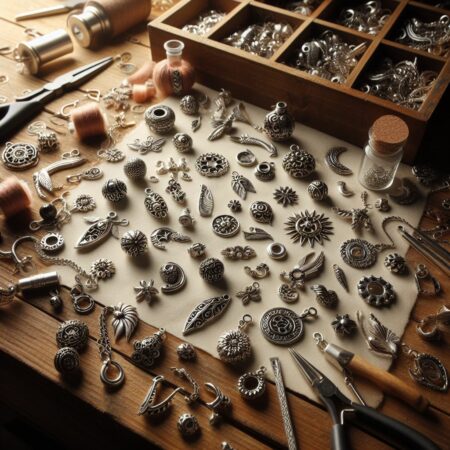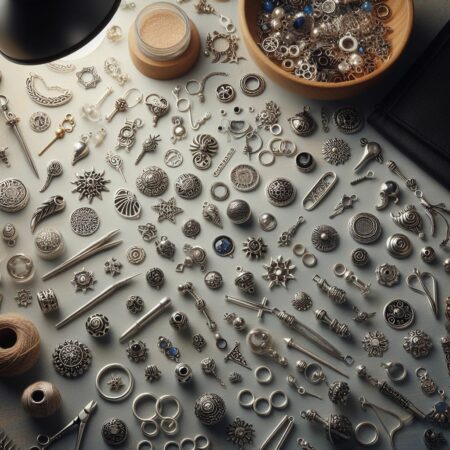You’re probably already aware of objects that bring good luck to life – these objects tend to be small and unusual, but they matter to you or people you know, and for the most part, they also seem to work.
Objects that bring good luck are often steeped in history and stories: they’re treasured regardless of age, and people who believe in them will hold on to them for a long time.
Many objects that bring good luck come in the form of everyday items. People give meaning and intention to these symbols or objects, which ultimately gives the power of luck to these objects.
If you’re interested in creating lucky bracelets and necklaces from the comfort of your home, you may want to try checking out Xinar’s extensive collections of 925 sterling silver charms.
Remember: all symbols and objects can become objects that bring good luck. Think animal or pet charms, holiday charms, love and peace charms, and even sports and outdoor charms. Any object or symbol you think might bring good luck to you because of its history or significance can become a good luck symbol.
Some Objects that Bring Good Luck
If you’re interested in some objects that bring good luck, below are some common and very unusual items that people deem to be lucky all over the world:
The Horseshoe
However, one good luck charm has been warding off evil spirits and providing good mojo for centuries.
Although the exact origins are unknown, it is believed that the horseshoe became the symbol of good fortune when Chaldeans of the eighth century believed its crescent shape represented various moon goddesses, thereby protecting against the evil eye.
Others believe horseshoes became synonymous with good fortune in 969 A.D. when St. Dunstan supposedly tricked Satan. There are several versions of the legend, but they all agree that St. Dunstan shod the Devil’s cloven hoof with great force and suffering.
Afraid of the tiny crescent-shaped object, the Devil agreed never to cross a threshold with a horseshoe nailed to it after the excruciating ordeal. A fortunate charm to ward off evil was created.
The horseshoe’s metal composition became a popular choice as a lucky charm. Most of the earliest horseshoes were made of iron, a durable metal but also believed to have magical properties; it is magnetic, runs abundantly through human bodies, and is said to keep fairies at bay. It was said that witches were so terrified of iron-made horseshoes that they chose to fly on broomsticks instead of using horses for transportation.
Jade
Jade is thought to bring good fortune. Similar to the belief that a four-leaf clover represents good fortune, it is believed that jade possesses protective, lucky-charm energy. Because of this, jade statues are commonly used in feng shui, and jade bracelets are often given to newborns in Asian cultures. Therefore, jade is thought to bring good fortune.
Like the belief that a four-leaf clover represents good fortune, it is believed that jade possesses protective, lucky-charm energy. Because of this, jade statues are commonly used in feng shui, and jade bracelets are often given to newborns in Asian cultures.
Jade aids in the recovery from trauma or a mindset of scarcity. Its unique molecular resonance is said to help re-calibrate your energy so that you can see the abundance around you, thereby increasing your faith in the universe’s ability to provide. Of course, this is a highly unscientific assertion. However, it wouldn’t hurt to keep some jade in your pocket just in case, would it?
Although jade is not as common as rose quartz, it has recently become much more accessible.
Bamboo
The history of the lucky bamboo plant dates back over 4000 years to Chinese culture. In Asian culture, it represents luck and is immensely famous during religious holidays, especially the New Year. In addition, lucky bamboo is commonly used in feng shui due to its association with Asia and its elegance, clarity, and symbolic meaning.
Surprisingly, lucky bamboo is not bamboo at all but rather a type of dracaena. Authentic bamboo is not intended to be grown as an indoor plant. However, because lucky bamboo is narrower, it can be used inside. Because it resembles natural bamboo, it can be used synonymously and carries the same feng shui meanings and symbols. It originated in Africa, thrives in Asia, and is a popular potted plant indoors.
It is an excellent complement to most residences, especially if you appreciate the aesthetic of bamboo, and is typically quite accessible.
Lucky bamboo is robust, overgrows, and recovers rapidly. It symbolizes erect growth, nobility, and adaptability. In addition, it has a hollow stem, which symbolizes an open and humble heart.
Bamboo’s rapid growth and adaptability make it a popular material for eco-friendly construction and home goods. As a result, it has come to represent sustainability in Western culture.
Fish and Water
Fish and water represent good fortune, wealth, and richness in feng shui. When you combine water and fish, you can increase the potency of these symbols.
Some ways to incorporate the symbols of fish and water into your house include aquariums, fish art, and so on.
An aquarium with fish also promotes harmonious energy in the home. The smoothness is associated with ease, just as the water and fish in an aquarium easily flow.
You can place the aquarium in your home’s Wealth (Xun) area to attract more prosperity. Fish can also be placed strategically near your home’s entrance to attract more riches from the outside world. If your aquarium features a waterfall, direct the water towards the core of your home.
Goldfish are traditionally used in feng shui aquariums. They are fortunate for several reasons. They are first associated with wealth and prosperity due to their golden hue.
Goldfish are carp, which in Asian cultures are considered very fortunate.
According to legend, in ancient China, there lived a powerful, strong, and resilient carp. This carp could swim upriver, against the Yellow River’s current, and up the Dragon’s Gate waterfall.
This carp transformed into a dragon after leaping over the Dragon’s Gate. Thus, carp (and goldfish) remind us that we, too, can overcome formidable obstacles and achieve success. Each of us possesses these qualities and opportunities. Additionally, we all possess the capacity for transformation.
If you decide to welcome this power into your home by keeping fish in an aquarium, it is important that you keep your tank clean. Choosing the appropriate size for your space and fish population is also essential. Finally, conduct extensive research on how to preserve the aquarium environment for the inhabitants. A filthy, unhealthy, and overlooked aquarium will attract the opposite of abundance.
Pig
The pig is a famous symbol of good fortune. This belief dates back to the Middle Ages when animals were regarded as a sign of prosperity. Not only were pigs omnivores, making them relatively simple to feed with leftovers, but they also reproduced rapidly, providing their owners with a constant food source. Consequently, those who could keep pigs endured significantly less of the gnawing hunger that plagued large portions of the population.
Even before pigs were domesticated, they were a welcome addition to the dinner table. Since prehistoric times, wild pigs have been hunted and consumed. Nonetheless, the animals were popular for more than just their succulent meat.
In Germanic cultures, the boar represented masculinity. As a result of its bravery and aggression, the Celts revered it as a symbol of war. The board has also earned a reputation as a heraldic animal, although not to the same extent as the lion, eagle, or bear.
Dreamcatcher
The dream catcher is among the most widespread and enduring Native American cultural symbols. It is commonly believed that the symbol is intended to “catch” bad dreams while allowing good ones to pass through, hence the name.
However, the true history of dream catchers is somewhat more complicated. While some see the dream catcher as a symbol of tribal unity, others believe it has been misappropriated and overcommercialized.
Despite this polarization, the origins of this lucky symbol and the perceptions surrounding it remain an exciting aspect of American history.
Numerous indigenous cultures feature protective fetishes, but the dream catcher most associated with Native Americans originally came from the Ojibwe (Chippewa) culture. Asibikaashi, or “the Spider Woman,” was a mother figure in Ojibwe mythology who served as a defender of the people, especially children.
As the Ojibwe nation expanded geographically, dream catchers became a proxy for Asibikaashi; a tool hung over children’s beds to grab any bad or evil before it could cause harm.
As Western tribes gradually interacted through intermarriage and trade, the legend of the dream catcher spread to other cultures. For example, the Lakota have a dream catcher legend associated with Iktomi, a trickster god who frequently took the form of a spider.
Dream catchers symbolize “the web of life,” comprised of numerous good and bad decisions in Lakota culture. The purpose of the dream catcher is to separate the good from the bad ideas of society, allowing people to realize their dreams and visions.
The American Barn Star
There are few more American symbols than a carved wood or steel star displayed on a house, barn, or storefront. Yet, despite their cultural homogenization in the melting pot of the United States, they are traditionally associated with Dutch heritage and architectural style in the midwest.
So it’s easy to see why they’ve been adopted as the ideal rustic statement piece, as they are both colorful and bold yet oddly simple. But have you ever regarded the origin of this country kitchen staple?
Barn stars are undeniably historical, but their precise origins and meanings are subject to numerous interpretations. However, from the 1700s to the 1820s, it is safe to say that these symbols were a common sight on the barns and homes of Pennsylvania Dutch communities.
After the Civil War, it appeared that there were even more stars. It appears that star types have evolved. Originally, designs had only three or four points, but eventually, five points became the standard.
While modern stars are typically made of wood or metal and are attached to structures, some ancient buildings have these elements built directly into the structure.
As opposed to having religious or superstitious significance, some traditional stars are a type of builder’s mark or are purely ornamental, according to experts. In addition, historians have linked star designs to specific barn builders in Pennsylvania. Therefore, consider it an early form of branding or trademark.
Early Germanic, Swedish, and Dutch settlers who established themselves in the Pennsylvania region brought a wealthy heritage and religious tradition. These were so firmly ingrained that their influence can still be seen in many Amish and ancient ethnic communities.
This includes the numerous “hex signs” predominant in artwork and household essentials. These can be lumped into the barn star identity, making the distinctions somewhat hazy.






